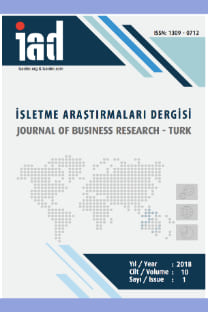An Investigation of Employee Performance Differences between Native and Immigrant Employees
An Investigation of Employee Performance Differences between Native and Immigrant Employees
___
- Aguinis, H. (2009). Performance Management (2nd ed.). Prentice Hall.
- Ahmad, S., & Shahzad, K. (2011). HRM and employee performance: A case of university teachers of Azad Jammu and Kashmir (AJK) in Pakistan. African Journal of Business Management, 5(13), 5249-5253.
- Arasli, H., Arici, H. E., & Ilgen, H. (2019). Blackbox between job crafting and job embeddedness of immigrant hotel employees: a serial mediation model. Economic Research, 32(1), 3935-3962.
- Benghoul, M. (2018). The Impact of Refugees on the Turkish Workforce. 4th International Social Science Congress (pp. 301-309). Nevşehir: Nevşehir Hacı Bektaş Veli University.
- Carrasco, R., Jimeno, J. F., & Ortega, A. C. (2008). The effect of immigration on the labor market performance of native-born workers: some evidence for Spain. Journal of Population Economics, 21, 627-648.
- Cho, G., Hwang, H., Sarstedt, M., & Ringle, C. M. (2020). Cutoff criteria for overall model fit indexes in generalized structured component analysis. Journal of Marketing Analytics, 8, 189-202.
- Chowan, J., Zeytinoglu, I. U., & Cooke, G. B. (2016). Immigrants and job satisfaction: Do high performance work systems play a role? Economic and Industrial Democracy, 37(4), 690-715.
- Diamantidis, A. D., & Chatzoglou, P. (2019). Factors affecting employee performance: an empirical approach. International Journal of Productivity and Performance Management, 68(1), 171-193.
- Esen, O., & Binatli, A. O. (2017). The Impact of Syrian Refugees on the TurkishEconomy: Regional Labour Market Effects. Social Sciences, 6.
- Griffin, M. A., Neal, A., & Neale, M. (2000). The contribution of task performance and contextual performance to effectiveness: Investigating the role of situational constraints. Applied Psychology: An International Review, 49(3), 517-533.
- Griffin, R. W., Welsh, A., & Moorhead, G. (1981). Perceived Task Characteristics and Employee Performance: A Literature Review. The Academy of Management Review, 6(4), 655-664.
- Hatane, S. E. (2015). Employee satisfaction and performance as intervening variables of learning organization on financial performance. Procedia - Social and Behavioral Sciences, 211, 619-628.
- Horverak, J. G., Bye, H. H., Sandal, G. M., & Pallesen, S. (2013). Managers’ Evaluations of Immigrant Job Applicants: The Influence of Acculturation Strategy on Perceived Person-Organization Fit (P-O Fit) and Hiring Outcome. Journal of Cross-Cultural Psychology, 44(1), 46-60.
- Konakay, G., Akdemir, A., & Mercanlioglu, A. C. (2021). The Effect of Organizational Innovation and Employee Empowerment on Job Performance: A Case of an Industrial Firm. Journal of Business Research - Turk, 13(1), 980-993.
- Massoudi, A. H. (2016). Employees performance dimensions in Kurdistan region hotel industry. International Journal of Recent Scientific Research, 7(10), 13534-13539.
- McCloy, R. A., Campel, J. P., & Cudeck, R. (1994). A confirmatory test of a model performance determininents. Journal of Applied Psychology, 79(4), 493-505.
- Park, S., & Park, S. (2019). Employee Adaptive Performance and Its Antecedents: Review and Synthesis. Human Resource Development Review, 18(3), 294-324.
- Pradhan, R. K., & Jena, L. K. (2017). Employee Performance at Workplace: Conceptual Model and Empirical Validation. Business Perspectives and Research, 5(1), 1-17.
- Raza, H., Anjum, M., & Zia, S. M. (2014). The Impacts of Employee’s Job Performance Behavior and Organizational Culture on Organizational Productivity in Pharmaceutical Industries in Karachi. Intercisciplinary Journal of Contemporary Research in Business, 5(12), 385-400.
- Shaheen, A., Naqvi, S. M., & Khan, M. A. (2013). Employees Training and Organizational Performance: Mediation by Employees Performance. Interdisciplinary Journal of Contemporary Research in Business, 5(4), 490-503.
- Shaikh, M. R., Tunio, R. A., & Shah, I. A. (2017). Factors Affecting to Employee’s Performance: A Study of Islamic Banks. International Journal of Academic Research in Accounting, Finance and Management Sciences, 7(1), 312-321.
- Tatar, E. L. (2011). The importance of measuring individual performance to increase organizational performance. Journal of Defense Resources Management, 1(2), 113-118.
- Tetik, S. (2019). The Effect on Work Motivation of Organizational Socialization in Public Organizations: A Research in Ihsaniye District. Journal of Business Research - Turk, 11(3), 1779-1791.
- Tinofirei, C. (2011). The Unique Factors Affecting Employee Performance In Non Profit Organisations. University of South Africa.
- Tuffaha, M. (2020). The determinants of employee's performance: A literaure review. Journal of Economics and Management Sciences, 3(3), 14-24.
- ISSN: 1309-0712
- Yayın Aralığı: 4
- Başlangıç: 2009
- Yayıncı: Melih Topaloğlu
An Investigation of Employee Performance Differences between Native and Immigrant Employees
Şule ERDEM TUZLUKAYA, Emad Anver ALBAYATI
Bağımsız Denetim Kalitesi Üzerinde Etkili Olan Faktörler Üzerine Bir Yapısal Eşitlik Modellemesi
Mahmut YARDIMCIOĞLU, Şebnem ADA
Bitcoin İçin Volatilite Tahmini: Simetrik ve Asimetrik Garch Modelleri İçin Ampirik Bir Uygulama
Gülfen TUNA, Ahmet Bülent ATASOY
Hakkı Okan YELOĞLU, Aysun DOĞAN
M. Murat NALCI, A. Buğra HAMŞIOĞLU
Bilişim Teknolojileri - İş Uyumlamasi İçin Gerekli Örgütsel Faktörler
